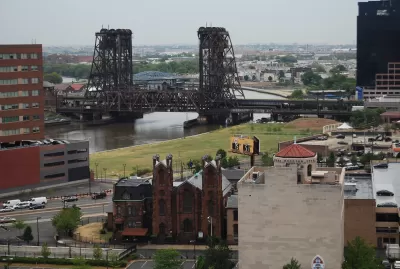In New Jersey, a cap-and-trade system existed for two decades and appeared to just perpetuate housing and social inequities. But now legislators and researchers are considering it again.

Kriston Capps writes that some New Jersey state legislators have proposed bringing back a cap-and-trade system for affordable housing that was in place from 1988 to 2008. In response to the Mount Laurel Doctrine, which required municipalities to produce affordable housing, New Jersey established new fair housing rules, including the cap-and-trade system. It permitted a municipality to pay another city or town to take on half of its affordable housing obligation.
This system undermined much of what the Mount Laurel Doctrine sought to achieve. Wealthy cities sent housing elsewhere, and those sending cities also saw huge gains in employment while the receiving ones lost jobs.
A reasonable conclusion is that bringing such a system back would just exacerbate inequality. "Cap and trade, after all, would seem to give rich communities an out on fair housing. This could reward the nation’s worst impulses, since opposition to low-income housing is often rooted in racism," notes Capps.
But Robert Wassmer and Imaez Wahid published a paper last year suggesting that a version of cap and trade might be a way to more readily reveal the underlying prejudices about affordable housing driving such a program in the first place:
Cap and trade between communities with similar outlooks and incomes would look different. Affluent NIMBYs would have to find other affluent NIMBYs and reach a deal, Wassmer says. This might shed light on the irrational beliefs (racism and classism) behind the rational motivations (perceived home value) underlying NIMBYism. Wassmer says that he predicts that in a true neighborhood cap and trade, no trading would happen at all.
They say that homeowners’ perceptions about the effects of affordable housing on property values are not totally irrational and a relationship does exist between racial demographics and home sales prices, even if other quality of life measures in a neighborhood do not change.
"Low-income housing doesn’t acidify the oceans or exacerbate forest fires. Unlike with climate change, there isn’t a NIMBY problem to solve except perception," notes Capps. Wassmer and Imaez suggest that putting a dollar value on these NIMBY perceptions and forcing cities to pay up could be an effective way to make communities rethink their views on affordable housing.
FULL STORY: Putting a Price on NIMBYism

Study: Maui’s Plan to Convert Vacation Rentals to Long-Term Housing Could Cause Nearly $1 Billion Economic Loss
The plan would reduce visitor accommodation by 25,% resulting in 1,900 jobs lost.

North Texas Transit Leaders Tout Benefits of TOD for Growing Region
At a summit focused on transit-oriented development, policymakers discussed how North Texas’ expanded light rail system can serve as a tool for economic growth.

Why Should We Subsidize Public Transportation?
Many public transit agencies face financial stress due to rising costs, declining fare revenue, and declining subsidies. Transit advocates must provide a strong business case for increasing public transit funding.

How to Make US Trains Faster
Changes to boarding platforms and a switch to electric trains could improve U.S. passenger rail service without the added cost of high-speed rail.

Columbia’s Revitalized ‘Loop’ Is a Hub for Local Entrepreneurs
A focus on small businesses is helping a commercial corridor in Columbia, Missouri thrive.

Invasive Insect Threatens Minnesota’s Ash Forests
The Emerald Ash Borer is a rapidly spreading invasive pest threatening Minnesota’s ash trees, and homeowners are encouraged to plant diverse replacement species, avoid moving ash firewood, and monitor for signs of infestation.
Urban Design for Planners 1: Software Tools
This six-course series explores essential urban design concepts using open source software and equips planners with the tools they need to participate fully in the urban design process.
Planning for Universal Design
Learn the tools for implementing Universal Design in planning regulations.
Ascent Environmental
Borough of Carlisle
Institute for Housing and Urban Development Studies (IHS)
City of Grandview
Harvard GSD Executive Education
Toledo-Lucas County Plan Commissions
Salt Lake City
NYU Wagner Graduate School of Public Service




























